COSPAR ID 2003-022A Dry mass 666 kg Period 7.5 hours Manufacturer EADS Astrium Satellites | Operator ESA SATCAT no. 27816 Inclination 86.3° Launch date 2 June 2003 | |
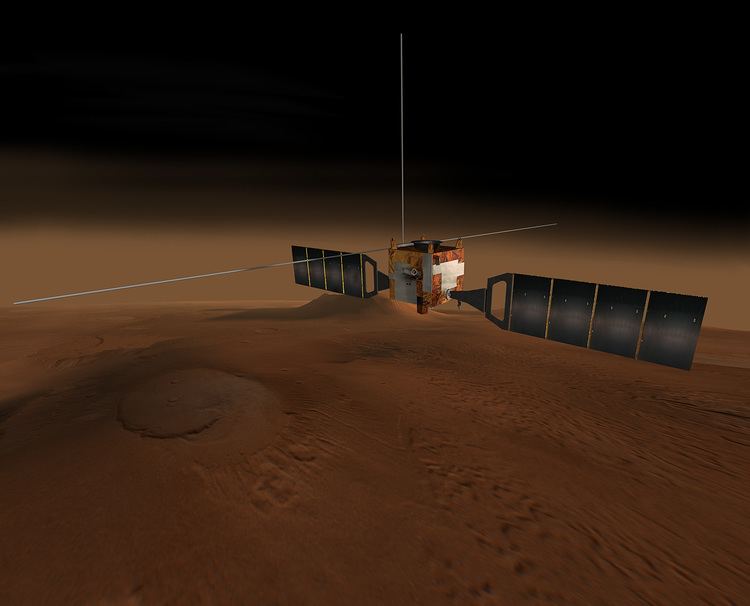 | ||
Website exploration.esa.int/mars Mission duration Elapsed:13 years, 9 months and 11 days since launch13 years, 2 months and 16 days at Mars Similar | ||
Mars express ten year highlights
Mars Express is a space exploration mission being conducted by the European Space Agency (ESA). The Mars Express mission is exploring the planet Mars, and is the first planetary mission attempted by the agency. "Express" originally referred to the speed and efficiency with which the spacecraft was designed and built. However "Express" also describes the spacecraft's relatively short interplanetary voyage, a result of being launched when the orbits of Earth and Mars brought them closer than they had been in about 60,000 years.
Contents
- Mars express ten year highlights
- Esa mission mars express hebes chasma fullhd 1080p
- Mission overview
- Mission preparation
- Launch
- Near Earth commissioning phase
- The interplanetary cruise phase
- Lander jettison
- Orbit insertion
- MARSIS deployment
- Operations of the spacecraft
- Routine phase science return
- Structure
- Propulsion
- Power
- Avionics
- Communications
- Earth stations
- Thermal
- Control unit and data storage
- Lander
- Scientific instruments
- Scientific discoveries and important events
- 2004
- 2005
- 2006
- 2007
- 2008
- 2009
- 2010
- 2011
- 2012
- 2013
- 2016
- Payload principal investigators links
- References

Mars Express consists of two parts, the Mars Express Orbiter and the Beagle 2, a lander designed to perform exobiology and geochemistry research. Although the lander failed to fully deploy after it landed on the Martian surface, the orbiter has been successfully performing scientific measurements since early 2004, namely, high-resolution imaging and mineralogical mapping of the surface, radar sounding of the subsurface structure down to the permafrost, precise determination of the atmospheric circulation and composition, and study of the interaction of the atmosphere with the interplanetary medium.
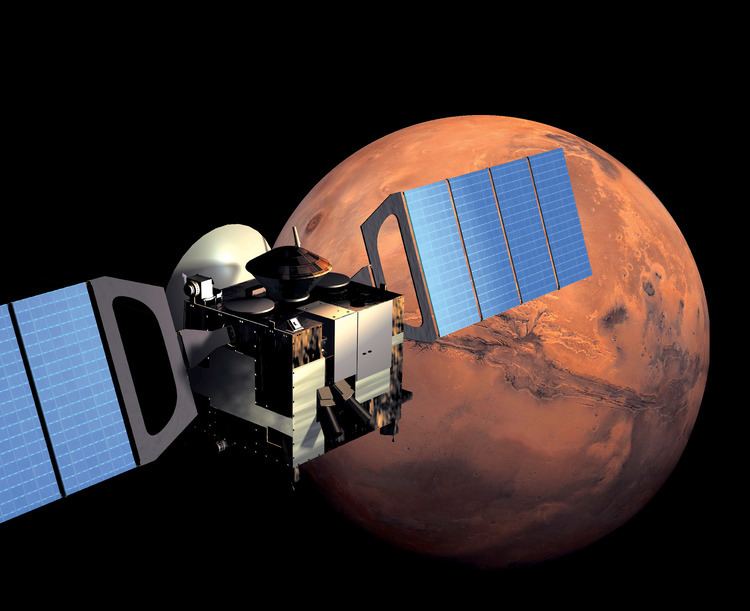
Due to the valuable science return and the highly flexible mission profile, Mars Express has been granted six mission extensions, the latest until the end of 2016.
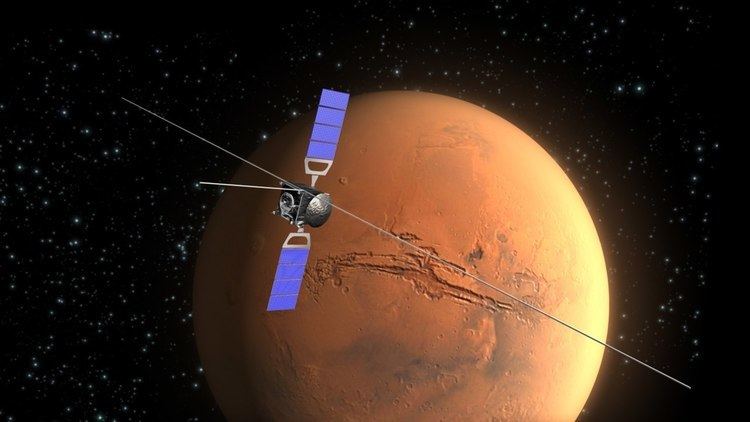
Some of the instruments on the orbiter, including the camera systems and some spectrometers, reuse designs from the failed launch of the Russian Mars 96 mission in 1996 (European countries had provided much of the instrumentation and financing for that unsuccessful mission). The design of Mars Express is based on ESA's Rosetta mission, on which a considerable sum was spent on development. The same design was also used for the Venus Express mission in order to increase reliability and reduce development cost and time. Because of these redesigns and repurposings, the total cost of the project was about $345 million- less than half of comparable U.S. missions.
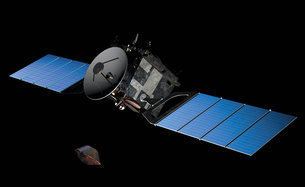
On 19 October 2014, the ESA reported the Mars Express is healthy after the Comet Siding Spring flyby of Mars on 19 October 2014 — as are, as well, all NASA Mars orbiters and ISRO's orbiter, the Mars Orbiter Mission.
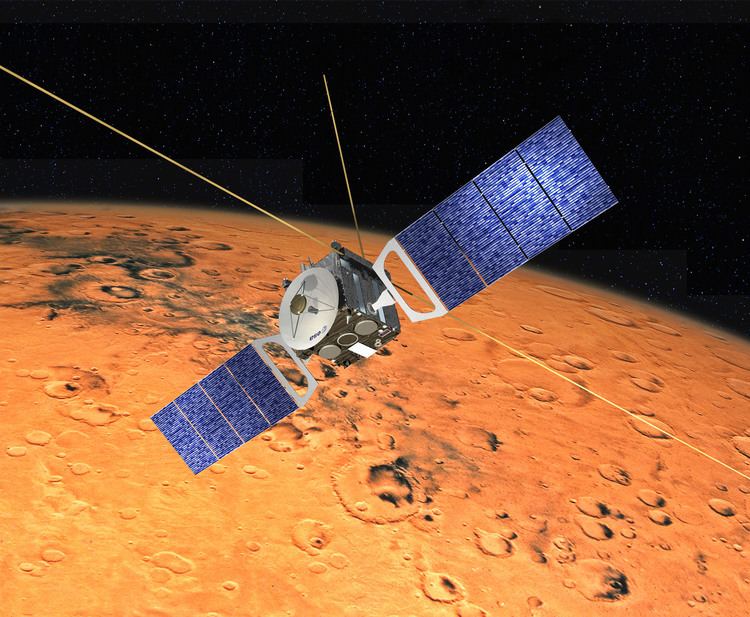
Arriving at Mars in 2003, 13 years, 2 months and 16 days ago (and counting), it is the second longest surviving, continually active spacecraft in orbit around a planet other than Earth, behind only NASA's still active 2001 Mars Odyssey.
Esa mission mars express hebes chasma fullhd 1080p
Mission overview
The Mars Express mission is dedicated to the orbital (and originally in-situ) study of the interior, subsurface, surface and atmosphere, and environment of the planet Mars. The scientific objectives of the Mars Express mission represent an attempt to fulfill in part the lost scientific goals of the Russian Mars 96 mission, complemented by exobiology research with Beagle-2. Mars exploration is crucial for a better understanding of the Earth from the perspective of comparative planetology.
The spacecraft originally carried seven scientific instruments, a small lander, a lander relay and a Visual Monitoring Camera, all designed to contribute to solving the mystery of Mars' missing water. All of the instruments take measurements of the surface, atmosphere and interplanetary media, from the main spacecraft in polar orbit, which will allow it to gradually cover the whole planet.
The total initial Mars Express budget excluding the lander was €150 million. The prime contractor for the construction of Mars Express Orbiter was EADS Astrium Satellites.
Mission preparation
In the years preceding the launch of a spacecraft numerous teams of experts distributed over the contributing companies and organisations prepared the space and ground segments. Each of these teams focussed on the area of its responsibility and interfacing as required. A major additional requirement raised for the Launch and Early Orbit Phase (LEOP) and all critical operational phases was that it was not enough merely to interface; the teams had to be integrated into one Mission Control Team. All the different experts had to work together in an operational environment and the interaction and interfaces between all elements of the system (software, hardware and human) had to run smoothly for this to happen:
Launch
The spacecraft was launched on June 2, 2003 at 23:45 local time (17:45 UT, 1:45 p.m. EDT) from Baikonur Cosmodrome in Kazakhstan, using a Soyuz-FG/Fregat rocket. The Mars Express and Fregat booster were initially put into a 200 km Earth parking orbit, then the Fregat was fired again at 19:14 UT to put the spacecraft into a Mars transfer orbit. The Fregat and Mars Express separated at approximately 19:17 UT. The solar panels were then deployed and a trajectory correction manoeuvre was performed on June 4 to aim Mars Express towards Mars and allow the Fregat booster to coast into interplanetary space. The Mars Express was the first Russian-launched probe to successfully make it out of LEO since the Soviet Union fell.
Near Earth commissioning phase
The Near Earth Commissioning phase extended from the separation of the spacecraft from the launcher upper stage until the completion of the initial check out of the orbiter and payload. It included the solar array deployment, the initial attitude acquisition, the declamping of the Beagle-2 spin-up mechanism, the injection error correction manoeuvre and the first commissioning of the spacecraft and payload (final commissioning of payload took place after Mars Orbit Insertion). The payload was checked out one instrument at a time. This phase lasted about one month.
The interplanetary cruise phase
This five month phase lasted from the end of the Near Earth Commissioning phase until one month prior to the Mars capture manoeuvre and included trajectory correction manoeuvres and payloads calibration. The payload was mostly switched off during the cruise phase, with the exception of some intermediate check-outs. Although it was originally meant to be a "quiet cruise" phase, It soon became obvious that this "cruise" would be indeed very busy. There were star Tracker problems, a power wiring problem, extra manoeuvres, and on the 28th of October, the spacecraft was hit by one of the largest solar flares ever recorded.
Lander jettison
The Beagle 2 lander was released on December 19, 2003 at 8:31 UTC (9:31 CET) on a ballistic cruise towards the surface. It entered Mars' atmosphere on the morning of December 25. Landing was expected to occur at about 02:45 UT on December 25 (9:45 p.m. EST December 24). However, after repeated attempts to contact the lander failed using the Mars Express craft and the NASA Mars Odyssey orbiter, it was declared lost on February 6, 2004, by the Beagle 2 Management Board. An inquiry was held and its findings were published later that year.
Orbit insertion
Mars Express arrived at Mars after a 400 million km journey and course corrections in September and in December 2003.
On December 20 Mars Express fired a short thruster burst to put it into position to orbit the planet. The Mars Express Orbiter then fired its main engine and went into a highly elliptical initial-capture orbit of 250 km × 150,000 km with an inclination of 25 degrees on December 25 at 03:00 UT (10:00 p.m., December 24 EST).
First evaluation of the orbital insertion showed that the orbiter had reached its first milestone at Mars. The orbit was later adjusted by four more main engine firings to the desired 259 km × 11,560 km near-polar (86 degree inclination) orbit with a period of 7.5 hours. Near periapsis the top deck is pointed down towards the Martian surface and near apoapsis the high gain antenna will be pointed towards Earth for uplink and downlink.
After 100 days the apoapsis was lowered to 10,107 km and periapsis raised to 298 km to give an orbital period of 6.7 hours.
MARSIS deployment
On May 4, 2005, Mars Express deployed the first of its two 20-metre-long radar booms for its MARSIS (Mars Advanced Radar for Subsurface and Ionosphere Sounding) experiment. At first the boom did not lock fully into place; however, exposing it to sunlight for a few minutes on May 10 fixed the glitch. The second 20 m boom was successfully deployed on June 14. Both 20 m booms were needed to create a 40 m dipole antenna for MARSIS to work; a less crucial 7-meter-long monopole antenna was deployed on June 17. The radar booms were originally scheduled to be deployed in April 2004, but this was delayed out of fear that the deployment could damage the spacecraft through a whiplash effect. Due to the delay it was decided to split the four week commissioning phase in two parts, with two weeks running up to July 4 and another two weeks in December 2005.
The deployment of the booms was a critical and highly complex task requiring effective inter-agency cooperation ESA, NASA, Industry and public Universities.
Nominal science observations began during July 2005. (For more info, see, and ESA Portal - Mars Express radar ready to work ESA press release.)
Operations of the spacecraft
Operations for Mars Express are carried out by a multinational team of engineers from ESA's Operation Centre (ESOC) in Darmstadt. The team began preparations for the mission about 3 to 4 years prior to the actual launch. This involved preparing the ground segment and the operational procedures for the whole mission.
The Mission Control Team is composed of the Flight Control Team, Flight Dynamics Team, Ground Operations Managers, Software Support and Ground Facilities Engineers. All of these are located at ESOC but there are additionally external teams, such as the Project and Industry Support teams, who designed and built the spacecraft. The Flight Control Team currently consists of:
The team build-up, headed by the Spacecraft Operations Manager, started about 4 years before launch . He was required to recruit a suitable team of engineers that could handle the varying tasks involved in the mission. For Mars Express the engineers came from various other missions. Most of them had been involved with Earth orbiting satellites.
Routine phase: science return
Since orbit insertion Mars Express has been progressively fulfilling its original scientific goals. Nominally the spacecraft points to Mars while acquiring science and then slews to Earth-pointing to downlink the data, although some instruments like Marsis or Radio Science might be operated while spacecraft is Earth-pointing.
Structure
The Mars Express Orbiter is a cube-shaped spacecraft with two solar panel wings extending from opposite sides. The launch mass of 1123 kg includes a main bus with 113 kg of payload, the 60 kg lander, and 457 kg of propellant. The main body is 1.5 m × 1.8 m × 1.4 m in size, with an aluminium honeycomb structure covered by an aluminium skin. The solar panels measure about 12 m tip-to-tip. Two 20 m long wire dipole antennas extend from opposite side faces perpendicular to the solar panels as part of the radar sounder.
Propulsion
The Soyuz/Fregat launcher provided most of the thrust Mars Express needed to reach Mars. The final stage of the Fregat was jettisoned once the probe was safely on a course for Mars. The spacecraft's on-board means of propulsion was used to slow the probe for Mars orbit insertion and subsequently for orbit corrections.
The body is built around the main propulsion system, which consists of a bipropellant 400 N main engine. The two 267-liter propellant tanks have a total capacity of 595 kg. Approximately 370 kg are needed for the nominal mission. Pressurized helium from a 35-liter tank is used to force fuel into the engine. Trajectory corrections will be made using a set of eight 10 N thrusters, one attached to each corner of the spacecraft bus. The spacecraft configuration is optimized for a Soyuz/Fregat, and was fully compatible with a Delta II launch vehicle.
Power
Spacecraft power is provided by the solar panels which contain 11.42 square meters of silicon cells. The originally planned power was to be 660 W at 1.5 AU but a faulty connection has reduced the amount of power available by 30%, to about 460 W. This loss of power does significantly impact the science return of the mission. Power is stored in three lithium-ion batteries with a total capacity of 64.8 Ah for use during eclipses. The power is fully regulated at 28 V, and the Terma power module (also used in Rosetta) is redundant. Main propulsion consists of 24 bipropellant 10 N thrusters. The spacecraft carried 1,670 kilograms (3,680 lb) of propellant at launch, composed of monomethylhydrazine fuel and dinitrogen tetroxide oxidiser, providing a maximum delta-v of 2,300 metres per second (7,500 ft/s). Four of the thrusters are used for delta-v burns. During routine phase, the spacecraft's power consumption is in the range of 450 W - 550 W.
Avionics
Attitude control (3-axis stabilization) is achieved using two 3-axis inertial measurement units, a set of two star cameras and two Sun sensors, gyroscopes, accelerometers, and four 12 N·m·s reaction wheels. Pointing accuracy is 0.04 degree with respect to the inertial reference frame and 0.8 degree with respect to the Mars orbital frame. Three on-board systems help Mars Express maintain a very precise pointing accuracy, which is essential to allow the spacecraft to communicate with a 35-metre and 70-metre dish on Earth up to 400 million kilometres away.
Communications
The communications subsystem is composed of 3 antennas: A 1.6 m diameter parabolic dish high-gain antenna and two omnidirectional antennas. The first one provide links (telecommands uplink and telemetry downlink) in both X-band (8.4 GHz) and S-band (2.1 GHz) and is used during nominal science phase around Mars. The low gain antennas are used during Launch and early operations to Mars and for eventual contingencies once in orbit. Two Mars lander relay UHF antennas are mounted on the top face for communication with the Beagle 2 or other landers, using a Melacom transceiver.
Earth stations
Although communications with Earth were originally scheduled to take place with the ESA 35-meter wide Ground Station in New Norcia (Australia) New Norcia Station, the mission profile of progressive enhancement and science return flexibility have triggered the use of the newest ESA ESTRACK Ground Station in Cebreros Station, Madrid, Spain.
In addition, further agreements with NASA Deep Space Network have made possible the use of American stations for nominal mission planning, thus increasing complexity but with a clear positive impact in scientific returns.
This inter-agency cooperation has proven effective, flexible and enriching for both sides. On the technical side, it has been made possible (among other reasons) thanks to the adoption of both Agencies of the Standards for Space Communications defined in CCSDS.
Thermal
Thermal control is maintained through the use of radiators, multi-layer insulation, and actively controlled heaters. The spacecraft must provide a benign environment for the instruments and on-board equipment. Two instruments, PFS and OMEGA, have infrared detectors that need to be kept at very low temperatures (about −180 °C). The sensors on the camera (HRSC) also need to be kept cool. But the rest of the instruments and on-board equipment function best at room temperatures (10–20 °C).
The spacecraft is covered in gold-plated aluminium-tin alloy thermal blankets to maintain a temperature of 10–20 °C inside the spacecraft. The instruments that operate at low temperatures to be kept cold are thermally insulated from this relatively high internal temperature, and emit excess heat into space using attached radiators.
Control unit and data storage
The spacecraft is run by two Control and Data management Units with 12 gigabits of solid state mass memory for storage of data and housekeeping information for transmission. The on-board computers control all aspects of the spacecraft functioning including switching instruments on and off, assessing the spacecraft orientation in space and issuing commands to change it.
Another key aspect of the Mars Express mission is the Mars Express AI Tool (MEXAR2). The primary purpose of the AI tool is the scheduling of when to download various parts of the collected scientific data back to Earth, a process which used to take ground controllers a significant amount of time. The new AI tool saves operator time, optimizes bandwidth use on the DSN, prevents data loss, and allows better use of the DSN for other space operations as well. The AI decides how to manage the spacecraft's 12 gigabits of storage memory, when the DSN will be available and not be in use by another mission, how to make the best use of the DSN bandwidth allocated to it, and when the spacecraft will be oriented properly to transmit back to Earth.
Lander
The Beagle 2 lander objectives were to characterize the landing site geology, mineralogy, and geochemistry, the physical properties of the atmosphere and surface layers, collect data on Martian meteorology and climatology, and search for possible signatures of life. However, the landing attempt was unsuccessful and the lander was declared lost. A Commission of Inquiry on Beagle 2 identified several possible causes, including airbag problems, severe shocks to the lander's electronics which had not been simulated adequately before launch, and problems with parts of the landing system colliding; but was unable to reach any firm conclusions. The spacecraft's fate remained a mystery until it was announced in January 2015 that NASA's Mars Reconnaissance Orbiter, using HiRISE, had found the probe intact on the surface of Mars. It was then determined that an error had prevented two of the spacecraft's four solar panels from deploying, blocking the spacecraft's communications. Beagle 2 was the first British and first European probe to achieve a landing on Mars.
Scientific instruments
The scientific objectives of the Mars Express Payload are to obtain global high-resolution photo-geology (10 m resolution), mineralogical mapping (100 m resolution) and mapping of the atmospheric composition, study the subsurface structure, the global atmospheric circulation, and the interaction between the atmosphere and the subsurface, and the atmosphere and the interplanetary medium. The total mass budgeted for the science payload is 116 kg.
Scientific discoveries and important events
For more than 5000 orbits, Mars Express Payload instruments have been nominally and regularly operated. HRSC camera has been consistently mapping the Martian surface with unprecedented resolution and has taken dozens of pictures.
